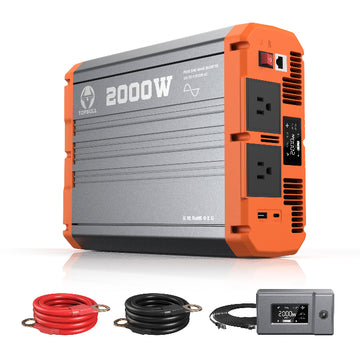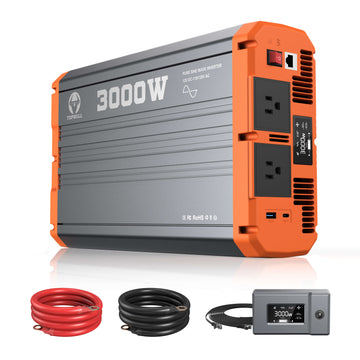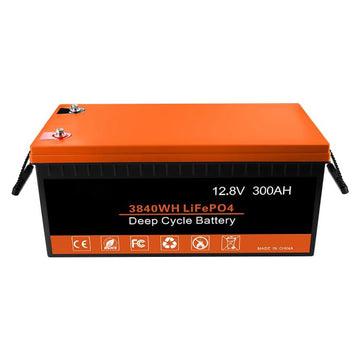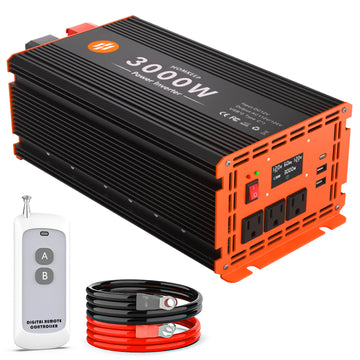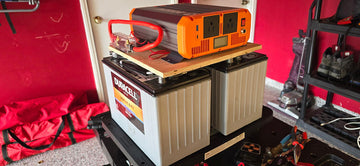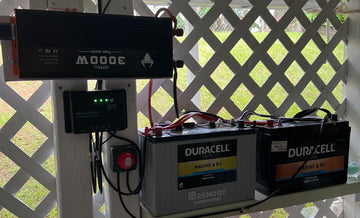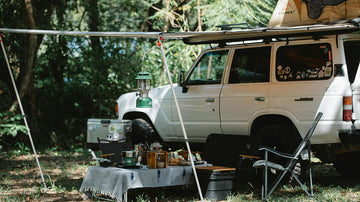What is a grid-tied solar system?
Grid-tied solar systems are connected to the public electricity grid while providing electricity to your home. Unlike off-grid systems, which are not connected to the utility company, solar panels send excess electricity to the grid and the utility company credits your account for the electricity you generate. You can use this electricity whenever you need it (for example, at night when the solar panels aren't producing solar energy).
If you're considering adding battery backup to your system, you've probably learned the hard way about the drawbacks of grid-tied solar without storage. The fact is that grid-tied systems are still vulnerable to blackouts. If you don't have a battery backup installed, you could find yourself without power until the electricity company repairs the outage.
Why add a battery to a solar system
A grid-tied system with energy storage (a hybrid system) can give you peace of mind during a power cut. There are also other benefits, as listed below.
- If a solar system produces more electricity than your household needs, the excess will be wasted if you don't qualify for the Net Marketing or Smart Export Guarantee (SEG).
- A battery bank can help smooth out the fluctuations in the power produced by a solar system, especially on cloudy days or at night, ensuring a steady supply of electricity.
- Batteries add flexibility to your system, allowing you to adjust how energy is used and stored as needed, and better manage the flow of energy.
Options for adding batteries to a grid-tied solar system
If you skipped installing batteries when you first installed your solar system and now want to add batteries to your system, there are several options:
Option1: AC coupling
Your existing system remains intact, and a battery-based inverter and battery bank are added to the existing grid-tied system, as well as the electrical sub-panel that contains the circuits for any base loads you wish to power during an outage. When grid power is available, the solar panels first supply power to the loads. Once these loads are satisfied, the excess power from the solar array charges your battery bank. When both the loads and the battery are satisfied, the system will feed power back to the grid if the solar panels are still producing excess power.
If the grid is interrupted, your grid-tied inverter will transfer power via an additional inverter connected to the batteries. The solar panels are still able to generate power, cover critical loads, and charge the batteries, only the excess power is no longer fed back into the grid.

Pros:
The easiest way to retrofit an existing solar system works with small battery systems and relatively low night-time consumption.
Cons:
- Lower efficiency than DC coupled systems, higher energy conversion, higher power losses during charging.
- Local utility companies set limits on the total size of the inverter. If the inverter or battery pack is too small, the system will perform poorly or not at all. In addition, if existing grid-connected inverters are large, AC-coupled systems can become very expensive.

Option 2: DC coupling
With DC-coupled energy storage systems, the battery is connected directly between the solar panel and the grid-connected inverter. No AC bus is required, allowing the solar DC to charge the battery directly. This allows the battery to be charged and discharged with minimal energy loss. Typically, an additional charge controller is required to manage the current from the solar panel to the battery.
Pros:
- More efficient than AC-coupled systems
- Less energy conversion losses during charge and discharge
- More accurate battery monitoring and control through a hybrid inverter
- Suitable for larger battery systems
Cons:
- DC-coupled solar is more suitable for new installations and new homes that don't have existing circuit boards, circuit breakers, and wiring.
- More technically complex, requiring system design expertise

Note: AC-coupled solar batteries require a storage inverter. DC-coupled systems require a solar inverter. Other components may be required depending on the model and manufacturer.
Option3: Storage-Ready Inverter
If neither of these methods is suitable for you, consider replacing the system's grid-tied inverter with an energy storage inverter. This approach is the most flexible option - it works for all existing grid-tied systems. In many cases, this solution is preferable to matching an existing system using AC or DC coupling because these inverters are designed with energy storage in mind. They have cool features like storing energy during peak times of use (TOU) and selling it back to the utility to take advantage of your local net metering policy. But it's the most expensive way to retrofit your system because it requires the most time and effort.
This method is difficult for microinverters because it requires more work to remove the old inverter and reinstall each panel. Labor costs are higher and take longer, so AC-coupled solutions are often a better option for microinverter systems.

Pros:
- Suitable for any system
- Energy storage inverters have additional features
Cons:
The most expensive option, especially for microinverters
Step to add a battery to an existing solar system
Determine loads: You should identify the major power-consuming appliances in your home, such as air conditioning, electric vehicle charging, electric water heaters, pool pumps, and pool heating loads. Evaluate the energy consumption patterns of these appliances and the timing of their electricity use to determine when electricity is most needed and to optimize the use of solar energy during the day when the solar system is operating.
Existing solar system: We need to know the make and model of the inverter and the size of the PV system connected to that inverter to determine the size and power requirements of the backup battery system connected to the inverter.
Electricity bill: Analysing the information contained in electricity tariffs is essential to designing the right storage system. If you have an existing solar system (which cannot be monitored online), we can calculate the approximate amount of excess solar power that is supplied to the grid each day that can be reused to charge new batteries or, if you do not have an existing solar system, we can design a DC coupled solar PV and battery storage system that is large enough to meet all existing and future loads.
Backup functionality: Critical circuits (lighting, power, and small air conditioning) can be transferred to the inverter's backup power supply. This involves reconfiguring the wiring or adding new backup switchboards for these circuits.
Choose the right battery: The next step is to select the battery that best suits your needs and ensure that it is compatible with and supports the work of your chosen hybrid inverter. The three most common types of batteries used in residential solar installations today are lead-acid, lithium-ion, and LiFePO4 batteries.
Installation and testing: You can install AC-coupled solar batteries, which require a storage inverter, or DC-coupled systems, which require a solar inverter, or replace your existing grid-tied inverter with a hybrid inverter that manages both solar panels and batteries. The battery of choice is then installed in the appropriate location and charged with DC solar energy.
Monitor your system: It's important to monitor your battery storage system to make sure it's working properly. Regularly check the state of charge of your battery to ensure it is charging and discharging as expected. Also, make sure your battery is clean and free of debris to prevent damage or malfunction.
If you are inexperienced in electrical work or unsure of how to connect circuits, always seek professional help to prevent electrical problems and ensure safety.
Is it worth adding a battery to existing solar panels?
Solar batteries are a great idea for homeowners who live in areas with high electricity bills, no net metering programs, frequent power outages, or limited daylight hours. In the long run, whether your goal is to improve energy security or maximize the return on your solar investment, adding battery storage to your residential PV system almost always pays off and can save you a lot of money!

